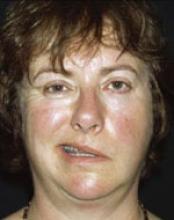A 10-day course of corticosteroids (prednisolone 25 mg twice daily) started within 72 hours significantly improves the chances of complete recovery. There is no added benefit from acyclovir.1
Strength of recommendation
A: Based on a large, well-designed randomized controlled trial
Sullivan FM, Swan IR, Donnan PT, et al. Early treatment with prednisolone or acyclovir in Bell’s palsy. N Engl J Med 2007;357:1598–1607.
Illustrative case
A 45-year-old man presents to your outpatient clinic within 24 hours after onset of left-sided facial nerve weakness and inability to smile on one side of his face. He asks for a therapy to help improve his symptoms quickly, as his daughter is getting married in a few months, and he will be in the wedding pictures.
Is there a treatment that will hasten his complete recovery?
Background: Insufficient statistical power until now
Many of us treat patients with Bell’s palsy with both corticosteroids and antiviral medications, such as acyclovir or valacyclovir, largely on the basis of pathophysiologic reasoning, because we’ve had no clear guidance from outcome studies. Until now, outcome studies have had mixed findings, and have been inconclusive.2 Most outcome studies have lacked the statistical power to either detect or to rule out potential benefits convincingly. The study by Sullivan and colleagues is the first to have a sufficiently large study sample from which to draw more definitive conclusions based on patient-oriented outcomes.
Steroid plus antiviral makes sense, pathophysiologically
Corticosteroids are thought to decrease inflammation of the facial nerve during an episode of facial paralysis. Some have postulated that herpes simplex virus type I may be a cause of facial nerve paralysis, hence the treatment with antivirals.3
Most of our PURL surveillance system clinician reviewers said that they prescribe both corticosteroids and antivirals.
Guidelines: “probably, possibly”
For example, a report of the Quality Standards Subcommittee of the American Academy of Neurology concluded that benefit from both steroids and antivirals has not been well established in patients with Bell’s palsy. However, the report states that evidence suggests that steroids are safe and probably effective, while antivirals are also safe and possibly effective.4
In contrast, UpToDate suggests treating all patients seen within a week of symptom onset with corticosteroids (prednisone 60–80 mg daily) plus valacyclovir (1 g 3 times daily) for 1 week.5
CLINICAL CONTEXT: Quality of life, risk of permanent harm
Bell’s palsy, defined as an acute peripheral facial weakness of unknown cause, has an annual incidence of 20 to 32 per 100,000. Most patients recover completely, with or without treatment, but 20% to 30% can have permanent facial weakness or paralysis.
The time to resolution is a quality of life issue for those in whom disease does not resolve spontaneously.6
We think that this study provides convincing evidence that acyclovir is not indicated for Bell’s palsy and that corticosteroids are.
STUDY SUMMARY: 10-day treatment, starting promptly
This double-blind, placebo-controlled, randomized, multifactorial trial compared recovery of facial nerve function for patients randomized to receive 10 days of treatment with prednisolone (25 mg twice daily), acyclovir (400 mg 5 times daily), both agents, or placebo (lactose).
Inclusion criteria
Patients had to be at least 16 years of age (average age=44), with unilateral facial nerve weakness of no identifiable cause (eg, a diagnosis of Bell’s palsy). They were recruited mostly through their family doctors (75%) but also through emergency rooms and dental offices, and were referred to otolaryngologists at 17 Scottish hospitals within 72 hours.
The degree of initial facial paralysis was moderate to severe, based on the House-Brackmann scale, a widely used system for grading recovery from facial nerve paralysis. After the onset of symptoms, most patients (53.8%) initiated treatment within 24 hours, 32.1% within 48 hours, and 14.1% within 72 hours. Patients were assessed at baseline, 3 months, and 9 months.
Exclusion criteria
Exclusion criteria included pregnancy, breastfeeding, uncontrolled diabetes (Hb A1c >8.0%), peptic ulcer disease, suppurative otitis media, herpes zoster, multiple sclerosis, systemic infection, sarcoid or other rare disorder, and inability to give informed consent.
FIGURE
Facial weakness or paralysis may be permanent
Although most patients with Bell’s palsy recover completely, with or without treatment, 20% to 30% can have permanent facial weakness or paralysis.
Primary outcome: Complete recovery
The study was designed to test the effectiveness of prednisolone and acyclovir’s effects on facial nerve recovery. The House-Brackmann scale was used to score recovery. The scale divides patients into 1 of 6 categories depending on the severity of facial nerve dysfunction, with grade 1 describing normal function and grade 6 indicating total paralysis.


